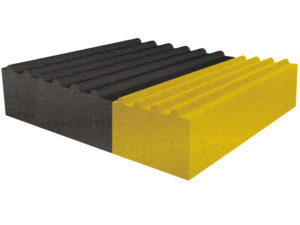Composite elements COMCON
The composite COMCON is a mixture of rough and fine particles (fillings) and a polymer binder.
Usage of composite polymer concrete COMCON
The COMCON elements and products can be used as safety aid for industry, construction and land communications as part of barrier free environment defined by EU regulations in general technical requirements ensuring barrier free use of buildings.
COMCON is used especially on the platforms in rail (trains, subway, trams) and public (bus or trolleybus terminals) transportation, pedestrian crossings, sidewalks mosaics, road and bridge curbs, etc.
Features of COMCON polymer concrete
The polymer binder passes on the material features that the cement concrete cannot reach:
- polymer concrete is colorfast, it maintains its signal function for its whole lifetime
- polymer concrete is impermeable, resistant to frost and thaw, resistant to physical and physical-chemical influence of aggressive factors
- polymer concrete is resistant to acid rains, spread salts, oil products, etc.
- the solidity of polymer concrete is several times higher than the one of cement concrete; the ratio of press and tensile firmness is much better and so is the resistance to impact
The most popular COMCON elements:
- The mosaic tiles COMCON. The tiles have regular embossments, so they create the impression of pavement mosaic. The mosaic cubes in a tile are unevenly profiled to be well tactually distinguishable from surrounding pavings.
- Interlocking pavement COMCON. Polymer concrete rectangular tiles with protrusions in shape of truncated cone.
- Profiled tile COMCON® VL with special tactile adjustment for visually impaired usable for artificial guiding lines and for guiding lines with the function of a warning strip (railways, platforms).
- Tiles COMCON MB and MC are designed for permanent marking of safety strips on subway or railway platforms; behind them the entry is forbidden. The tiles MBV and MCV have protrusions so they signal to the blind persons too.

